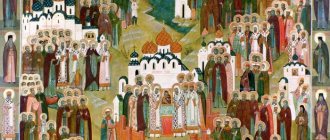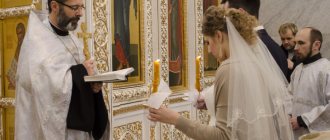This is why we need to get married so that it will help us lead a chaste life; and this will be the case if we take such brides who can bring us great chastity, great modesty. A wife is a haven and the most important cure for mental illness. If you keep this pier free from winds and waves, you will find great peace in it, but if you disturb and agitate it, then you are preparing for yourself the most dangerous shipwreck. (St. John Chrysostom).
The wife is given to the husband to help, so that the husband, with her consolation, can endure everything that happens to him in life. And if the wife is meek and adorned with virtues, then not only with her company she will bring comfort to her husband, but in general she will provide him with great benefit, making everything easier for him, helping him in everything, not leaving him in difficult trials, like those external (outside the home). , and those that happen every day in the house; but, like a skilled helmsman, she, with her prudence, will calm down every spiritual storm in him and with her cohabitation will give him consolation. For those living in such a union of marriage, nothing in real life can sadden them too much, nothing can disturb their peaceful happiness (St. John Chrysostom).
Marriage is a gift of God, sanctified by the blessing of the Church. The very first act of the Creator after the creation of husband and wife was to bless them to “be fruitful and multiply”; this is how the blessing of marital cohabitation and childbearing took place so that family members would simultaneously be members of the Church of Christ. The Lord Jesus Christ not only confirmed the original blessing of marriage, but also restored the law about it to its original force. Contrary to the Mosaic Law, which still allows the dissolution of marriage, Christ decisively prohibits divorce. And to the question of the Pharisees, “Is it permissible to divorce your wife for any reason?” he pointed to the original law of the unity and indissolubility of marriage, established by the first marriage couple Adam and Eve, and added:
If God unites, let not man separate.
The Gospel of Luke (chapter 102) says that marriage will cease to exist only when there is no death. The interpretation of this Gospel says:
The sons of this age, who in this world give birth and with those who give birth, marry and encroach. For centuries, their sons will neither have anything of the kind nor die, and may be deprived of marriage there. Where is the death of marriage for the sake of death? Marriage is for the sake of death, it is an exercise in death. What does marriage require? Marriage is a help to mortals and fulfillment of lack.
In the life of St. Nicholas the Wonderworker there is a description of a miracle about three virgins: an impoverished husband, the father of three daughters, wanted to give them to a shameful and lawless fornication in order to thus alleviate poverty in the family. To prevent these intentions, Saint Nicholas secretly appeared in his house three times with bundles of gold and with his help contributed to the fact that all three girls were legally married. From this it is clear that Saint Nicholas recognized the need for the marriage union, as the Sacrament of Marriage, sanctified by the Church. This event took place in the 4th century, when there were no wedding rites yet, and marriages were performed only with a parental blessing in the presence of witnesses (Book Kormchaya, page 500).
Wedding in Rus'
In the Old Testament, marriage was revered even higher than virginity, and fornicators and adulterers were killed with stones (Bible, Leviticus, Chapter 20 and Deuteronomy, Chapter 22). The Prophet Jeremiah also did not disdain marriage and advised the Israelis to enter into one, and when the marriage of Tobiah, the son of Tobit, took place, the incorporeal servant of the Lord, Archangel Raphael, arrived at his house. (Book of Tobit, 1-14 ch.)
The Gospel of John (chapter 6) describes the celebration of a marriage in Cana of Galilee, to which Jesus Christ Himself and the Most Holy Theotokos were invited. Christ honored this wedding feast with his presence and made up for the lack of wine by miraculously transforming simple water into the best wine. The first miracle described in the Gospel is confirmation that the Savior himself blessed this marriage, performed at home.
Marriage in Cana of Galilee. The miracle of turning water into wine (John 2:1-11). Fragment of "Maesta" by Duccio, 1308 - 1311.
Church marriage in Russia: a brief excursion into history
For many years in the Russian state, in order to recognize a marriage as official, a mandatory wedding of a man and a woman in a church was required. As a matter of fact, the Orthodox Church in this sense then performed the functions of modern registry offices, in charge of issues of registering marriages. The union of a man and a woman without a wedding was very rare in those days.
The situation changed radically after the revolution of 1917, when the role of the church in society was leveled and the state became secular. From that time on, only the union of a man and a woman registered by the state through the relevant authorities began to be recognized as an official marriage.
This state of affairs has remained in Russia to this day.
As for modern world experience, in some countries of the world, including secular and democratic ones, religious marriage has legal force.
About the sacrament of marriage. History of origin and content of the wedding ceremony
Marriage as a spiritual unity was established by the Lord in paradise. “ And the Lord God said: It is not good for man to be alone; Let us create for him a helper suitable for him. The Lord God formed from the ground every animal of the field and every bird of the air, and brought it to man to see what he would call them, and that whatever man called every living soul, that would be its name. And the man gave names to all the livestock, and to the birds of the air, and to every beast of the field; but for man there was no helper like him. And the Lord God caused the man to fall into a deep sleep; and when he fell asleep, he took one of ribs and covered that place with flesh . And the Lord God created a wife from a rib taken from a man, and brought her to the man. And the man said, Behold, this is bone of my bones, and flesh of my flesh; she will be called woman, for she was taken from man. Therefore a man will leave his father and mother and cleave to his wife; and they will become one flesh"
(Genesis 2, 18–24).
In the Old Testament, after the Fall, the meaning of marriage was procreation. Everyone hoped that the Savior would one day incarnate in his family. The absence of children was considered God's punishment for sins. In biblical history there is evidence that some Jews had concubines, and there were cases of divorce. But, even despite this, the family as an inseparable union of two people remained a model. The seventh commandment of Moses says: “You shall not commit adultery” (Ex. 20:14). The marital unions of the Old Testament righteous prophets Zechariah and Elizabeth, the godfathers Joachim and Anna, are to this day the ideal of married life for Christians.
With the coming of Christ, the moral requirements for maintaining spiritual purity in marriage increase: “ You have heard what was said to the ancients: do not commit adultery. But I tell you that anyone who looks at a woman lustfully has already committed adultery with her in his heart” ( Matthew 5:27
–
28)
. In the New Testament, the highest aspiration is dispassion and chastity, but marriage is indicated as a feasible path to salvation for everyone. John Chrysostom writes: “I consider virginity much more honorable than marriage; and yet, through this, I do not rank marriage among the bad deeds, but even highly praise it.”
There is a widely known mention in the Gospel of the moment when the Lord Jesus Christ honored with his presence a marriage in Cana of Galilee. As St. Augustine writes, “Christ appeared at the marriage (at Cana) to confirm that He Himself had established marriage in Paradise.” The mention of such an ordinary everyday event testifies to its enormous significance. Over time, marriage was recognized as one of the seven church sacraments performed on a person, to which an adult Christian resorts at his request, since, unlike other sacraments such as Baptism, Confirmation, Repentance and Communion, the sacrament of marriage is not necessary for salvation.
Does a church marriage have legal force?
A so-called religious marriage in modern Russian family law is not recognized as official if it is not registered in the manner prescribed by law with the registry office. That is, a union concluded between a man and a woman in a church, but not registered in the registry office, from a legal point of view is not a marriage at all.
At the same time, the state does not prohibit weddings in a temple, however, it does not recognize any legal consequences for this procedure.
Accordingly, such a union does not entail the emergence of any rights and obligations provided for by the Family Code of the Russian Federation and other laws of our country, regardless of what local or national customs provide
However, there are exceptions to this rule. But read about this in the next chapter.
How did the rite of a church wedding develop?
In the first century after the Birth of Christ, in apostolic times, Christians did not have a legalized wedding priesthood; marriages were performed at home, with a triple blessing, since churches did not yet exist.
There were different positions among the apostles regarding marriage. Thus, the Apostle Paul spoke of Christianity as an immaculate, sinless, ascetic religion. Peter called for early marriages and the inclusion of everyone in marriage.
Married life should be chaste. The main source of chastity is the Church. In his letter to the Ephesians, the Apostle Paul elevates Christian marriage to the meaning of the union of Christ with the Church, as head with body. This union is mysterious, because it is incomprehensible:
This is a great mystery; I speak in relation to Christ and to the Church (Eph. 5; 31-32).
“This is the law of God, which combines husband and wife, established for the propagation of the human race and for the limitation of lust,” is how early Christian theologians describe the reasons for marriage.
...To avoid fornication, each one have his own wife, and each one have his own husband (1 Cor. 7:2).
Thus, one must get married in order to lead a chaste life. Saint John Chrysostom advises parents to preserve the chastity of their sons by marrying them earlier, and to prevent fornication it is necessary to unite their son in marriage with a chaste and reasonable wife, who will keep her husband from a reckless lifestyle.
The Church clearly opposes civil marriages - cohabitation without a church blessing is considered the greatest sin.
In the interpretation of St. John Chrysostom on the First Epistle to Timothy, the Apostle Paul says:
For this reason, crowns are placed on the heads, the formation of victory, as if they were invincible, so they come to the bed of the invincible bystanders from sweetness. If he was caught out of lust, the harlots themselves from a distance, for the sake of other things and to have a crown on their head, they are defeated. We teach them these things, we punish them with them, we frighten them with them, we forbid them, when they do this, when they do it.
The Apostle Paul about the meaning of marriage in human life in his letters:
It’s better to get married than to get thin (chapter 136). Even if you get married, you have not sinned, and even if you have violated a virgin, you have not sinned (chapter 138). Even if an angel brings you good news, let him be anathema (chapter 199).
In the book of Ephraim the Syrian (word one) it is said:
Nowhere is it written that if you don’t understand a wife, you shouldn’t have children. The heretics abhorred marriage and did not accept sinners for repentance; they were called purists (Prince Helmsman, 1st Council, pr. 8th).
According to the apostolic rules: a marriage-borer cannot be a confessor (right 51 Apostolic); those who sin should be accepted to repentance (Apostolic Pr. 52). A bigamist or a concubine cannot be a confessor (right 17 of the Holy Apostle); for the sake of the priesthood, do not let go of your wife, i.e., the confessor must not be separated from his lawful wife (St. Apostle 5); prodigal priest - let him not be (Book Nomakanon pr. 181, 182 and 183).
The Apostle Paul, in Christ's teaching on the indissolubility of marriages (1 Cor. 7:10), supports the prohibition of interreligious marriages, but if one of the spouses has converted to Christianity, husband or wife, then they can save each other. The dissolution of such a marriage is possible only at the request of the non-Christian party (1 Cor. 7; 12-16).
Emperor Alexei Komnenos (1081–1118) for the first time issued a decree on church weddings among Christian slaves, who had until now been denied this, since they did not recognize the equality of masters and slaves in the face of the Christian faith alone. The same phenomenon was characteristic of the first years of the adoption of Christianity in Rus', when church marriage embraced noble people, and the lower class was left to live without a wedding.
The stage preceding the wedding was associated with betrothal, which in early Christianity took place several years before marriage, and during the life of the groom no one could marry this bride.
The holiness of Christian weddings and marriages was combined with the communion of the Holy Mysteries. The wedding took place during the Liturgy or immediately after it.
Sacrament of wedding. Photo taken from an open group of the social network VKontakte
For violation of marital fidelity, the Church excommunicated from Communion of the Holy Mysteries for a period of 7 to 15 years. It was also forbidden to ordain bigamous men to the sacred degrees. They were also prohibited from Communion of the Holy Mysteries for 1 year, and triplets - for 3 years as punishment for lack of patience, self-control and devotion to the will of God. During the wedding, prayers were read to such couples for forgiveness of the sin of carnal weakness, which prompted them to enter into a new marriage, since the Church looked at a third marriage better than debauchery.
S.S. Kuzin. "Wedding. Towards the light of God"
The sanctity of the marriage union is insulted not only by adultery, but also by other sins: discord, resentment, which ultimately leads to divorce. Saint John Chrysostom teaches us that marriage is not so that we fill our homes with enmity and hatred, have quarrels and dissensions, start disagreements with each other and make life miserable, but so that we can benefit from help, have a haven, a refuge and consolation in times of adversity, in order to find pleasure in conversation with his wife. “Do you want your wife to obey you, husband, as the Church obeys Christ? - asks Saint John Chrysostom, - take care of her yourself, as Christ takes care of the Church. Teach your wife the fear of God, and everything will flow to you as from a source, and your house will be filled with numerous blessings.”
In “Conversations on Marriage,” St. John Chrysostom writes:
From love comes constant chastity... From chastity comes love, and from love comes countless benefits. Just as it is impossible for a chaste man to despise his wife and ever neglect her, so it is impossible for a depraved and dissolute man to love his wife, even if she were the most beautiful of all. It is not so much external things that make spouses amiable and pleasant to each other, but chastity, kindness, affection and willingness to die for each other.
In Rus', in order to protect the bride from anything that could harm her modesty and chastity, she did not see the groom until the wedding.
N. A. Antokhina-Kuraksa. "Peasant wedding" 2004
The rite of church weddings developed gradually. In Rus' in the 11th-12th centuries the Sacrament of Marriage was already performed, but its order has not been preserved to this day. In the 16th-17th centuries, the wedding rite finally took on the form that is now used by Old Believers who accept the priesthood.
On the influence of romanticism
There are no patterns or stencils into which human life could be accommodated according to general parameters. Life is always more than a diagram. When we talk today about the structure of the family, the Christian family, we must understand that the family in the 21st century is built completely differently than it was in the 20th century, and certainly not differently than in the 19th century. Such social institutions that would prepare people for family life, now, alas, do not exist. The very continuity of these institutions has been lost.
Reading classical literature, we see how people formed families. This was done solely with the blessing of the parents, or because the young people were matched, introduced somehow specifically to start a family. It is quite difficult to imagine such a form of family structure today. This form is broken.
We read books and see that people who were matched to each other, who met literally in front of their parents and did not have the opportunity to communicate much, nevertheless later created strong and prosperous families. There was no talk of any romance or falling in love then. It was Russian and French literature of the 19th century that put the principle of romance and love in first place. And this principle was essentially destructive for the family even then. The stories of Zola, Maupassant and many others, all these Madame Bovary - this is what destroys the family, and does not at all glue it together.
Today, a person understands family precisely from these (bookish) positions: I am in love, I am amazed. And on this basis a person tries to build relationships and create a family. But is this the right way? How not to make a mistake in choosing? Where is the family that will correspond to the Christian ideal?
Hell devours, love opens
Try living together before marriage so you don't make a mistake with your choice. Try, “like all normal people.” The call is a deception that this world persistently offers us. But you can’t even try. Because a person’s quest is not to try “this,” but to try something else. We should not try each other, but test and open ourselves to each other, get to know each other. And for this we lack simple communication.
We Christians cannot do many things, but even more often we come up with things that we cannot do. Without any doubt, we should not sin and taste people. Because “trying someone” is a property of hell: devouring someone and something all the time. Hell is always consuming. And love is always shared and revealed. Our Christian property is that we know how to open up and are not afraid of it. From a Christian point of view, getting to know each other means opening up, understanding that in this openness there is a place for you. And this happens gradually, little by little, little by little in mutual recognition, when people open up to each other equally. And when they open up to the end, they recognize each other: “And I recognized you. It turns out that you are mine.” - "And you are mine".








